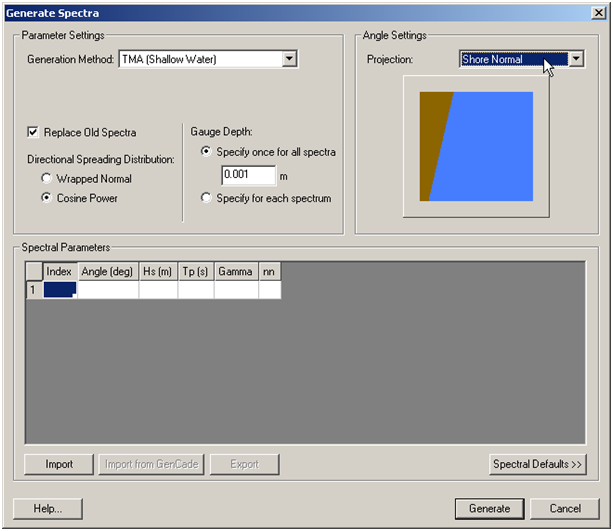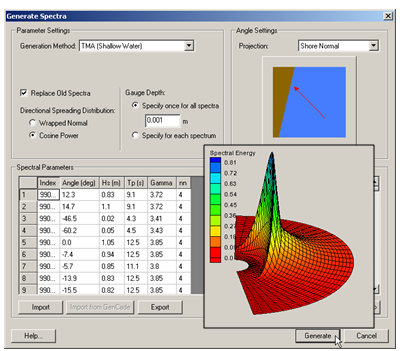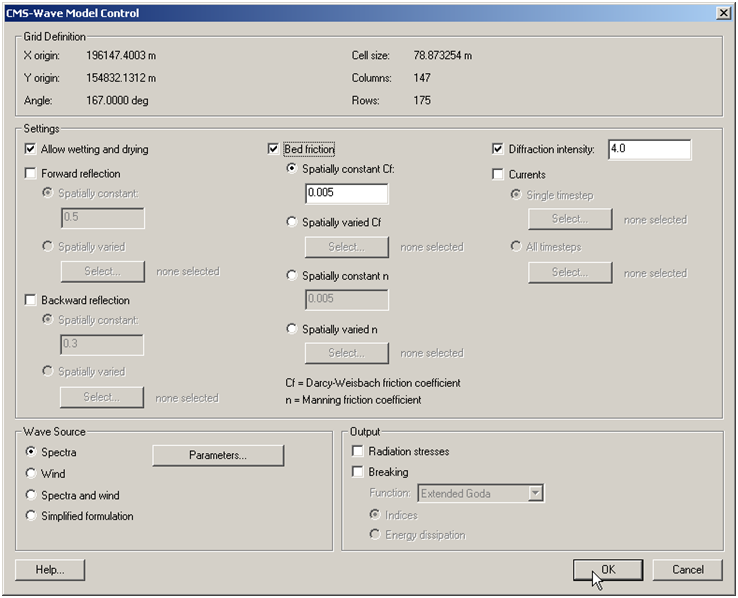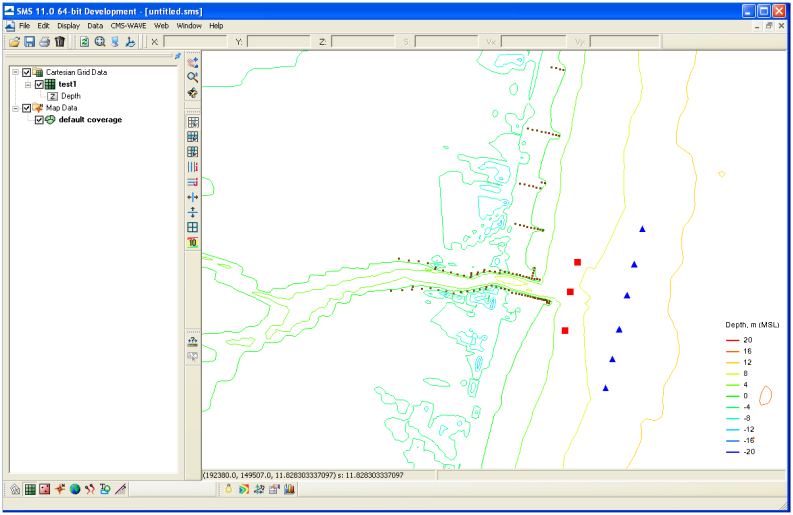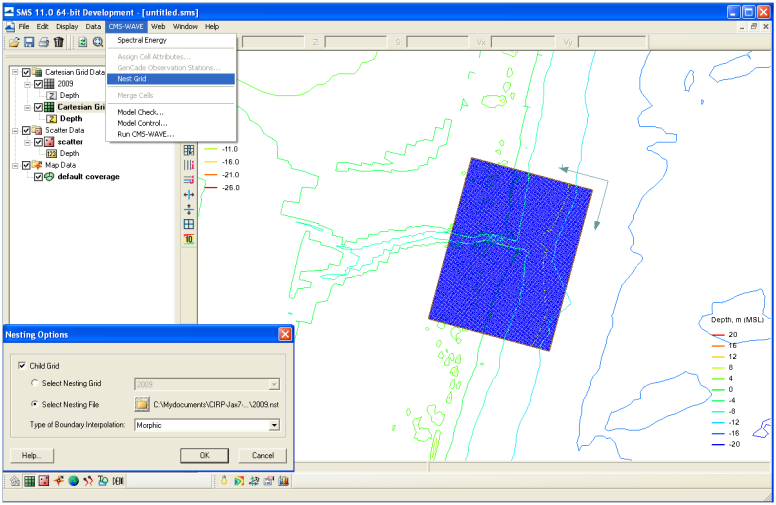User Guide 015: Difference between revisions
No edit summary |
No edit summary |
||
| (3 intermediate revisions by the same user not shown) | |||
| Line 66: | Line 66: | ||
:= 5, for composite or rubble-mound breakwater | := 5, for composite or rubble-mound breakwater | ||
:= 6, for a highly permeable structure like the pier or bridge | := 6, for a highly permeable structure like the pier or bridge | ||
:=7, for a low-permeable structure, like the rubble-mound breakwater | := 7, for a low-permeable structure, like the rubble-mound breakwater | ||
:cstruc | :cstruc = feature structure characteristic length | ||
:= feature structure depth, for kstruc = 1 (assume a land cell if not provided) | := feature structure depth, for kstruc = 1 (assume a land cell if not provided) | ||
:= beach/structure elevation above mean water level, for kstruc = 2 (use the input depth if not provided; no effect for cstruc < 0) | := beach/structure elevation above mean water level, for kstruc = 2 (use the input depth if not provided; no effect for cstruc < 0) | ||
| Line 76: | Line 76: | ||
In the Figure 2 example, users can modify 2009.struct to assign South Jetty 6 seaward end breakwater cells as permeable ones. The top 10 lines of the modified 2009.struct is shown below (the number 191 in the first row is the total structure cells in *.struct) | In the Figure 2 example, users can modify 2009.struct to assign South Jetty 6 seaward end breakwater cells as permeable ones. The top 10 lines of the modified 2009.struct is shown below (the number 191 in the first row is the total structure cells in *.struct) | ||
:191 | : 191 | ||
:76 110 7 1.5 | : 76 110 7 1.5 | ||
:77 110 7 1.5 | : 77 110 7 1.5 | ||
:78 110 7 1.5 | : 78 110 7 1.5 | ||
:79 110 7 1.5 | : 79 110 7 1.5 | ||
:76 111 7 1.5 | : 76 111 7 1.5 | ||
:77 111 7 1.5 | : 77 111 7 1.5 | ||
:91 10 5 | : 91 10 5 | ||
:92 10 5 | : 92 10 5 | ||
:93 10 5 | : 93 10 5 | ||
[[File:Fig_2-103.png]] | [[File:Fig_2-103.png]] | ||
| Line 93: | Line 93: | ||
=Grid Nesting= | =Grid Nesting= | ||
Grid Nesting – Users can use the CMS-Wave ''Assign Cell Attributes'' and ''Nesting Output'' (Figure | Grid Nesting – Users can use the CMS-Wave ''Assign Cell Attributes'' and ''Nesting Output'' (Figure 3-103) to specify the wave information output cells for saving spectrum data file (to serve as wave input to a child grid run). Figure 3-104 shows 6 nesting output locations (blue triangle) using the Shark River 2009.sim case. The nesting output file is *.nst (in the case of running CMS steering, an additional file nst.dat is automatically generated that merge all individual cycle *.nst files). | ||
Figure | Figure 3-105 shows a child grid domain (c2009.sim) within the parent grid (the child grid was generated based on scatter points converted from the parent grid). The child grid wave input file (2009.nst, as generated from the parent grid) shall be assigned in the child *.std. This can be done by manually editing the child *.std or using the SMS CMS-Wave and Nest Grid menu (Figure 3-104). | ||
[[File:fig_2-104.png]] | [[File:fig_2-104.png]] | ||
| Line 125: | Line 125: | ||
Spatially varied spectral input – This is simply the case as in a child grid that spatially varied wave spectra are permitted to assign at user specified locations along or near the seaward boundary of the child grid. To apply spatially varied spectra for wave input without a parent grid, users will need to prepare the wave input file with the format as described in the child grid run. | Spatially varied spectral input – This is simply the case as in a child grid that spatially varied wave spectra are permitted to assign at user specified locations along or near the seaward boundary of the child grid. To apply spatially varied spectra for wave input without a parent grid, users will need to prepare the wave input file with the format as described in the child grid run. | ||
A FORTRAN program '''merge-eng-to-nst.exe''' is provided to combine all wave spectra files (*.eng) from individual locations into a single wave in-put file in the format for spatially varied spectral input to CMS-Wave. Figure 3 | A FORTRAN program '''merge-eng-to-nst.exe''' is provided to combine all wave spectra files (*.eng) from individual locations into a single wave in-put file in the format for spatially varied spectral input to CMS-Wave. Figure 3-107 shows the map of two locations that each location has a wave input files available, 2009-ndbc.eng at Pt 1 (coordinates are 192,602 m and 151,037 m) and 2009-sp154.eng at Pt 2 (coordinates are 192,315 m and 149,579 m) – recall that 2009-ndbc.eng and 2009-sp154.eng were originally generated for the parent grid. Figure 3-108 shows running '''merge-eng-to-nst.exe''' in DOS to combine two wave input files into one single wave input file (spatially varied spectral wave input to the child grid). Because 2009-ndbc.eng and 2009-sp154.eng were generated respect to the shore-normal direction at 167 deg and the local child grid orientation is 165 deg, a -2 deg direction adjustment is needed in running '''merge-eng-to-nst.exe''' here. | ||
It is required that all individual wave input files must cover the same period and timestamps (users must edit the files to fill the missing data). In the example, wave spectra at time stamps 09122000, 0912003, and 0912006 are missing in 2009-ndbc.eng, and wave spectra at | It is required that all individual wave input files must cover the same period and timestamps (users must edit the files to fill the missing data). In the example, wave spectra at time stamps 09122000, 0912003, and 0912006 are missing in 2009-ndbc.eng, and wave spectra at time stamps 09120400 and 09121000 are missing in 2009-sp154.eng. Two revised files, 2009-ndbc-edit.eng and 2009-sp154-edit.eng (cover the time period from 09120103 to 09123121 in 3-hr interval) are actually used in '''merge-eng-to-nst.exe''' to generate c2009.nst. | ||
[[fig_2-107.png]] | [[File:fig_2-107.png]] | ||
Figure 3-107. Child grid domain and two wave input locations Pt1 and Pt2 | Figure 3-107. Child grid domain and two wave input locations Pt1 and Pt2 | ||
[[fig_2-108.png]] | [[File:fig_2-108.png]] | ||
Figure 3-108. Example of running merge-eng-to-nst.exe in DOS. | Figure 3-108. Example of running merge-eng-to-nst.exe in DOS. | ||
Latest revision as of 19:34, 8 May 2015
3 CMS-Wave Model Setup
Spectral waves or wave parameters can be generated for the wave grid forcing, or wind direction and speeds can provide the necessary infor-mation for wind- wave generation. Full (directional) spectra can be im-ported into the SMS for the CMS-Wave, as well as simplified wave pa-rameters (angle, wave height, and period, etc). The spectral energy file format is given in Appendix A, as well as guidelines for using automated programs to generate these files from NOAA/NDBC raw buoy data.
Adding Wave Parameter Generated Spectra to CMS-Wave
- 1. Click on CMS-Wave, Spectral Energy, and select Create Grid (wave spectra can be imported),
- 2. Click OK for the default spectral properties, and then click Generate Spectra to bring up the window to input wave parameters (Figure 3-101),
- 3. Open the Excel spreadsheet 44025buoy_199902.xls and select the wave parameters (1 month, Feb 1999), copy and paste this into the Generate Spectra – Spectral Parameters section (Figure 3-101), click Generate, OK.
- 4. Go to CMS-Wave, Model Control, and turn on Allow wetting and drying and Bed friction (Figure 3-102),
- 5. Users can also specify constant or varied forward and backward re-flection coefficients in Settings.
- 6. Water level and wind information are optional source as specified under Wave Source in addition to the spectral input data.
- 7. File, Save As, Wave.sim (selecting the Save As Type as a .sim for simulation) in the folder with the CMS-Flow grid.
Figure 3-101. Top Generating wave spectra from wave parameter input; Bottom: Generated wave parameters with a snapshot of spectral output.
Figure 3-102. CMS-Wave model control options
Advanced CMS-Wave Features
The most recent CMS-Wave code developed is Version 3-2. Several new capabilities and advanced features in this version include:
- • Full-plane
- • Automatic wave run-up calculation
- • Infra-gravity wave
- • Nonlinear wave-wave interaction
- • Muddy bottom
- • Binary file output
- • Selection of multiple processors
- • Permeable structure
- • Spatially varied wind input
- • Spatially varied spectral input
- • Grid nesting
- • Wave surging (roller) in surf zone
Full-plane
In this mode, CMS-Wave performs two half-plane runs in the same grid. The first run is in the half-plane with the principle wave direction toward the shore. The second run is in the seaward half-plane. Upon the completion of the second run, two half-plane results are combined to one full-plane solution. Because the run time for the full-plane is approximately twice of the regular half-plane, users shall consider the full-plane mode only if the full-plane features like wave generation and propagation in a bay or around an island. An example is to run the Shark River wave case, 2009.sim, in the full plane (modify 2009.std).
Wave Run-up, Infra-gravity Wave, Nonlinear Wave-Wave Interaction, Muddy Bed, Spatial Wind Input
To include (trigger) either of wave run-up, infra-gravity wave, nonlinear wave-wave interaction, binary (xmdf) output, multiple processors, muddy bed, and spatial wind field input is just a one-click step in the SMS11.1 interface. Additional files are required for the muddy bed and spatial wind field input.
If the muddy bed calculation is required, users shall prepare a mud.dat file or *.mud (in the same format as *.dep) to list the spatial maximum kinematic viscosity for the entire grid (recommended maximum kinematic viscosity for mud is 0.04 m2/sec)
If the spatial wind field input is required, users shall prepare a wind.dat file or *.wind (in the same format as *.cur) to provide the x- and y-component wind speed data corresponding to the incident wave condi-tions in the model grid.
Permeable Structures
Users will need to select and specify permeable structure cells through SMS11.1 CMS-Wave Assign Cell Attributes and select Permeable Breakwater (see Figure 3-103). In SMS11 or lower version which does not have the permeable structure cell feature, users will need to modify the *.struct to manually assign the permeable structure cells of interest. Recall that each feature cell is described by four parameters, istruc, jstruc, kstruc, and cstruc in a line format in *.struct (CMS-Wave Technical Report CHL-TR-08-13).
istruc = i-th column in the grid
jstruc = j-th row in the grid
kstruc = feature cell identity
- = 1, for adding alternative feature or structure (immersed or ex-posed) without modifying the input depth
- = 2, for calculation of wave runup and overwash on beach face or structure, and adjacent land
- = 3, for calculation of transmitted waves of a floating breakwater
- = 4, for vertical wall breakwater
- = 5, for composite or rubble-mound breakwater
- = 6, for a highly permeable structure like the pier or bridge
- = 7, for a low-permeable structure, like the rubble-mound breakwater
- cstruc = feature structure characteristic length
- = feature structure depth, for kstruc = 1 (assume a land cell if not provided)
- = beach/structure elevation above mean water level, for kstruc = 2 (use the input depth if not provided; no effect for cstruc < 0)
- = floating breakwater draft, for kstruc =3 (skip if not provided or cstruc < 0.05 m)
- = breakwater/structure elevation, for kstruc = 4 or 5 (use the input depth if not provided; immersed if cstruc < 0)
- = the permeable portion (>0, the section below the mean water depth) of a high-crest structure for kstruc = 6 or 7
In the Figure 2 example, users can modify 2009.struct to assign South Jetty 6 seaward end breakwater cells as permeable ones. The top 10 lines of the modified 2009.struct is shown below (the number 191 in the first row is the total structure cells in *.struct)
: 191 : 76 110 7 1.5 : 77 110 7 1.5 : 78 110 7 1.5 : 79 110 7 1.5 : 76 111 7 1.5 : 77 111 7 1.5 : 91 10 5 : 92 10 5 : 93 10 5
Figure 3-103. CMS-Wave Assign Cell Attributes in SMS11.1
Grid Nesting
Grid Nesting – Users can use the CMS-Wave Assign Cell Attributes and Nesting Output (Figure 3-103) to specify the wave information output cells for saving spectrum data file (to serve as wave input to a child grid run). Figure 3-104 shows 6 nesting output locations (blue triangle) using the Shark River 2009.sim case. The nesting output file is *.nst (in the case of running CMS steering, an additional file nst.dat is automatically generated that merge all individual cycle *.nst files).
Figure 3-105 shows a child grid domain (c2009.sim) within the parent grid (the child grid was generated based on scatter points converted from the parent grid). The child grid wave input file (2009.nst, as generated from the parent grid) shall be assigned in the child *.std. This can be done by manually editing the child *.std or using the SMS CMS-Wave and Nest Grid menu (Figure 3-104).
Figure 3-104. Nesting output 6 locations (blue triangle) and monitoring output 3 stations (red square).
Figure 3-105. The child grid domain and spectral input stations (blue triangle).
Figure 3-106. CMS-Wave Nest Grid and Nesting Options menu in SMS11.1
The child wave input file format is almost identical to the parent *.eng. The only difference is that the child wave input has additional 3 parame-ters (the local x and y coordinates, and local significant wave height at the spectral wave input location) in the individual spectral header along with the regular 5 parameters (spectral id, wind speed, wind direction, spectral peak frequency, water level adjustment) in the parent *.eng. The top 10 lines of 2009.nst are shown below (notice the 8th line is a spectral header for the 1st individual wave input spectrum):
30 35 6 167.00
0.04 0.05 0.06 0.07 0.08 0.09 0.10 0.11 0.12 0.13
0.14 0.15 0.16 0.17 0.18 0.19 0.20 0.21 0.22 0.23
0.24 0.25 0.26 0.27 0.28 0.29 0.30 0.31 0.32 0.33
9120103 9.80 -221.0 0.1200 0.00 192440.33 150712.28 0.563
0.00 0.00 0.00 0.00 0.00 0.00 0.00 0.00 0.00 0.00 0.00 0.00 0.00 0.00 0.00 0.00 0.00
0.00 0.00 0.00 0.00 0.00 0.00 0.00 0.00 0.00 0.00 0.00 0.00 0.00 0.00 0.00 0.00 0.00
To run the child grid in the steering mode, the spectral wave input file needs to be renamed to a default “nest.dat” (overwrite the wave input filename in the child *.std). It is noted that this “nest.dat” is only required for the child steering run. The parent grid run must be conducted and completed first to start a child grid run irrespective of whether CMS-Wave is or is not coupled with CMS-Flow (see more information in ERDC/CHL CHETN-IV-76).
Spatially Varied Spectral Wave Input
Spatially varied spectral input – This is simply the case as in a child grid that spatially varied wave spectra are permitted to assign at user specified locations along or near the seaward boundary of the child grid. To apply spatially varied spectra for wave input without a parent grid, users will need to prepare the wave input file with the format as described in the child grid run.
A FORTRAN program merge-eng-to-nst.exe is provided to combine all wave spectra files (*.eng) from individual locations into a single wave in-put file in the format for spatially varied spectral input to CMS-Wave. Figure 3-107 shows the map of two locations that each location has a wave input files available, 2009-ndbc.eng at Pt 1 (coordinates are 192,602 m and 151,037 m) and 2009-sp154.eng at Pt 2 (coordinates are 192,315 m and 149,579 m) – recall that 2009-ndbc.eng and 2009-sp154.eng were originally generated for the parent grid. Figure 3-108 shows running merge-eng-to-nst.exe in DOS to combine two wave input files into one single wave input file (spatially varied spectral wave input to the child grid). Because 2009-ndbc.eng and 2009-sp154.eng were generated respect to the shore-normal direction at 167 deg and the local child grid orientation is 165 deg, a -2 deg direction adjustment is needed in running merge-eng-to-nst.exe here.
It is required that all individual wave input files must cover the same period and timestamps (users must edit the files to fill the missing data). In the example, wave spectra at time stamps 09122000, 0912003, and 0912006 are missing in 2009-ndbc.eng, and wave spectra at time stamps 09120400 and 09121000 are missing in 2009-sp154.eng. Two revised files, 2009-ndbc-edit.eng and 2009-sp154-edit.eng (cover the time period from 09120103 to 09123121 in 3-hr interval) are actually used in merge-eng-to-nst.exe to generate c2009.nst.
Figure 3-107. Child grid domain and two wave input locations Pt1 and Pt2
Figure 3-108. Example of running merge-eng-to-nst.exe in DOS.
